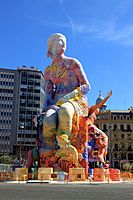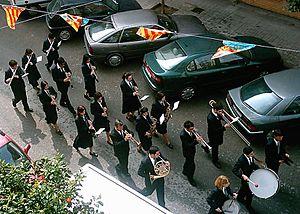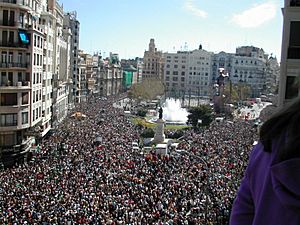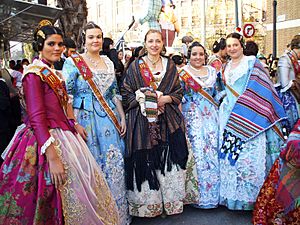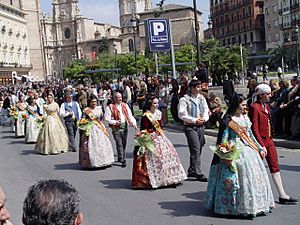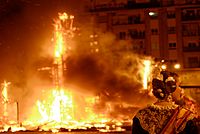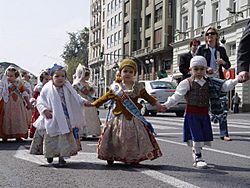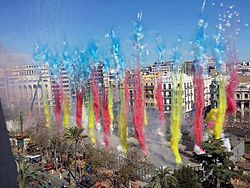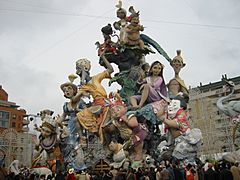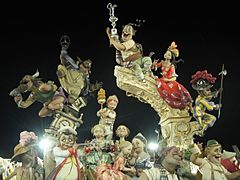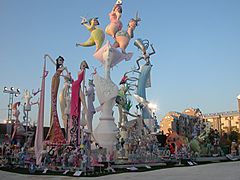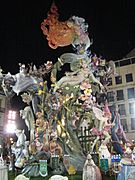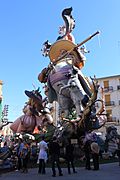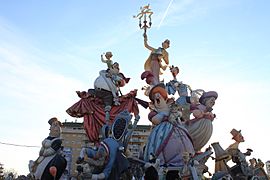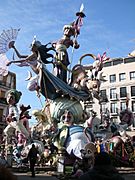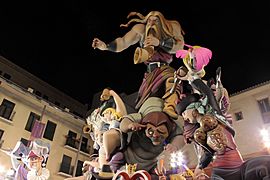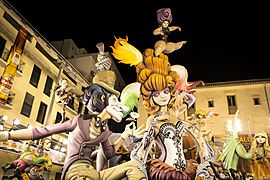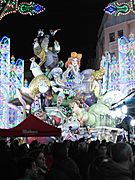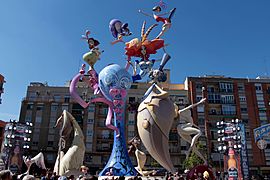Falles facts for kids
Quick facts for kids Valencia Falles |
|
|---|---|

Falla Na Jordana 2003 (1st prize)
|
|
| Date(s) | 15 to 19 March |
| Frequency | Annual |
| Location(s) | Valencia, Spain |
| Valencia Falles festival | |
|---|---|
|
UNESCO Intangible Cultural Heritage
|
|
| Country | Spain |
| Domains | Social practices, rituals and festive events |
| Reference | 859 |
| Region | Europe and North America |
| Inscription history | |
| Inscription | 2016 (11th session) |
| List | Representative |
The Falles (Valencian: Falles; Spanish: Fallas) is a huge yearly party in Valencia, Spain. It celebrates Saint Joseph. The main days are from March 15 to 19. But the fun starts earlier! From March 1 to 19, you can hear the Mascletà every day. This is a loud show of firecrackers and fireworks.
The word Falles means two things. It is the name of the festival itself. It also refers to the giant art pieces, called Falla (singular) or Falles (plural), that are burned at the end. Other towns in the Valencian Community also have similar parties. In 2016, UNESCO added the Falles festival to its list of important human heritage.
Each neighborhood in Valencia has a group called a Casal faller. These groups work all year to raise money for their falla. They often host parties and dinners, serving paella, a famous dish from the region. Each casal faller builds a falla monument that will be burned. There are about 400 casals fallers in Valencia.
Contents
What Does Falles Mean?
The name of the festival, Falles, comes from the Valencian language. It is the plural of the word falla. The word originally came from the Latin word fax, which means "torch." So, Falles basically means "torches."
Giant Art: Falles and Ninots
For a long time, casal faller groups spent many hours making ninots. These are like puppets or dolls. In the four days before March 19, each group parades their ninot. Then, they set it up on a huge art piece. This art piece is made of cardboard and paper-mâché, filled with firecrackers. The whole artwork is called a falla.
The ninots and their falles usually have a special theme. This theme is often a funny or critical look at things that caught the attention of the fallers. Fallers are the people who belong to the casals. Today, the festival is so big that there is a special area called Ciutat fallera (Falles City). Here, artists and craftspeople work for months. They create amazing structures of paper, wax, wood, and polystyrene foam. Some of these can be as tall as a five-story building! They feature funny figures, often caricatures, in surprising poses. Each falla is made under the guidance of a neighborhood casal faller. These groups compete to have the best artists and the most amazing monument. There are about 750 such groups in Valencia. More than 200,000 people are members, which is a quarter of the city's population!
During Falles, many people wear special clothes. These are traditional and historical costumes from different times in Valencia's past. You will often hear the dolçaina (a type of oboe) and the tabalet (a Valencian drum). Most casals fallers have their own traditional music bands.
Even though Falles is a very old event, the ninots can be very modern. In 2005, there were ninots of Shrek and George W. Bush. In 2012, you could see Barack Obama and Lady Gaga as ninots.
What Happens During Falles?
The five days and nights of Falles are like one big street party. There are many parades. Some are historical, some religious, and some are funny. Restaurants are full, and people spill out into the streets. You can hear explosions all day and sometimes at night. Everyone, from kids to older people, throws fireworks and noisemakers. The streets get covered in firework bits. The events happen on the same dates every year.
The Wake-Up Call: La Despertà
Each day of Falles starts at 8:00 am with La Despertà. This means "the wake-up call." Brass bands come out from the casals. They march down every street playing lively music. Right behind them are the fallers. They throw big firecrackers in the street as they go.
The Firecracker Show: La Mascletà
The Mascletà is a loud show of firecrackers and fireworks. It happens at 2:00 pm every day of the festival. The main Mascletà is in the Plaça de l'Ajuntament (City Hall Square). Here, firework experts compete to put on the best show. The winner gets to do the final Mascletà on March 19. At 2:00 pm, the clock chimes. The Fallera Major, who is the festival queen, calls out from the City Hall balcony: Senyor/a pirotècnic/a, pot començar la mascletà! This means "Mr./Ms. Pyrotechnic, you may start the Mascletà!" Then, the show begins.
The Mascletà is very special to the Valencian Community. Valencian people love it. Smaller neighborhoods often have their own mascletàs for special days or parties. Sometimes, there's a night version of the Mascletà. On some days, women pyrotechnicians are chosen to compete. You can watch this event on TV across the region.
Setting Up: La Plantà
On March 15, all the falles infantils (children's falles) must be finished. Later that night, all the falles majors (big falles) must be ready. If they are not finished, they can be disqualified from the competition.
Flower Offering: L'Ofrena de flors
In this event, each casal faller brings flowers to the Virgin Mary. She is known as Our Lady of the Forsaken. This happens all day on March 17 and 18. A large statue of the Virgin Mary is then covered with all the beautiful flowers.
Firework Nights: Els Castells and La Nit del Foc
On the nights of March 15, 16, 17, and 18, there are big firework shows. These happen in the old riverbed in Valencia. Each night's show is bigger than the last. The final one is called La Nit del Foc (the Night of Fire). It is truly spectacular!
Fire Parade: Cavalcada del Foc
On the last evening of Falles, at 7:00 pm on March 19, there is a parade. It is called the Cavalcada del Foc (the Fire Parade). It takes place along Colon street and Porta de la Mar square. This parade celebrates fire, which is a symbol of the festival. It is a colorful and noisy event. It includes floats, giant moving figures, people in costumes, rockets, gunpowder, street shows, and music.
Traditional Dressing
The traditional clothes worn by male "falleros" have changed over time. They used to wear black trousers and jackets with white shirts. Now, they wear more colorful and historical costumes with many decorations. These outfits can be quite expensive. But they are not as costly as the dresses worn by the "reinas falleras" (queens of the festival). Female traditional dresses can cost from 2,000 to over 20,000 Euros! Some of them are incredibly beautiful. They are worn with traditional hairstyles and jewelry.
The Burning: La Cremà
-
Mascletà in Valencia
On the final night of Falles, around midnight on March 19, all these falles are burned. They become huge bonfires. This event is called La Cremà (the Burning). It is the most exciting part of the whole festival. This is why the art pieces are called falles, meaning "torches." The falla in the Plaça de l'Ajuntament is usually burned last.
All casals also have a falla infantil (a children's falla). These are smaller and do not have funny or critical themes. They are burned first, at 10:00 pm. The main neighborhood falles are burned closer to midnight. The burning of falles in the city center often starts even later. For example, in 2005, the fire department waited until 1:30 am to burn a large falla. They wanted to make sure it was safe.
Each falla is filled with fireworks. These are lit first. The falla itself is set on fire either during or after the fireworks explode. Falles burn very quickly. The heat from them is very strong. For the larger ones, the heat can push the crowd back several meters. In narrow streets, the heat can scorch nearby buildings. Firefighters spray water on building fronts, window blinds, and street signs. This stops them from catching fire or melting.
Away from the burning falles, people have fun in the streets. The whole city feels like a giant outdoor dance party. But instead of music, you hear the constant sound of fireworks. Many stalls sell snacks like fried porres, churros, and bunyols. You can also find roasted chestnuts.
While smaller falles burn around the city at the same time, the very last falla to burn is the main one. This is the one outside the Ajuntament (city hall). People arrive hours early to get a good spot to watch. This final falla is burned after the Fallera Major gives the official signal.
History of Falles
There are different ideas about how the Falles festival began. One idea is that it started in the Middle Ages. Back then, craftspeople would burn broken items and wood they saved during winter. They did this to celebrate the start of spring. Carpenters in Valencia used wooden planks called parots to hang their candles on in winter. When spring came, they didn't need them anymore, so they burned them. Over time, the Church made the burning of these parots happen on the day of Saint Joseph. He is the patron saint of carpenters.
This tradition changed over time. People started dressing the parot in clothes to make it look like a person. They often added features that looked like someone famous from the neighborhood. Children would go from house to house asking for una estoreta velleta (an old rug). They added these old things to the parot to burn. This became a popular song that children sang while gathering old furniture and tools for the bonfire. These parots were the first ninots. Later, neighborhoods started organizing the building of the falles. This led to the detailed and complex artworks we see today.
Until the early 1900s, falles were tall boxes with three or four wax dolls dressed in cloth. This changed when artists started using cardboard. Today, the biggest falles are made of polystyrene and soft cork. These materials can be easily shaped with hot saws. This allows artists to create falles that are over 30 meters (about 100 feet) tall!
The Falles festival is similar to the Bonfires of Saint John in the Alacant region. Both came from an old Latin custom of lighting fires to welcome spring. In Valencia, this old tradition led to burning collected waste, especially wood, at the end of winter. This happened on Saint Joseph's Day. Valencians are known for their humor. So, it was natural for people to burn figures that showed people and events from the past year. Burning these figures showed freedom from old memories. It also allowed for funny and often critical comments on events. The festival became more about satire and irony. The wooden scraps slowly became more detailed "monuments" that were designed and painted beforehand.
In the early 1900s, especially during the Spanish Civil War, the monuments became more critical of the Church and government. The government tried to ban Falles many times, but they never succeeded. During the time of Francisco Franco's rule, the festival lost some of its funny, critical side because of government rules. But the monuments were one of the few public ways people could express themselves freely in Valencia. During this time, many religious customs, like offering flowers to Mare de Déu dels Desamparats (Our Lady of the Forsaken), became part of the festival. Today, these are important parts of Falles, even though they weren't part of the original tradition.
When democracy returned to Spain, the critical falles came back. Some were even a bit rude. Even with freedom of speech, some falleros still have traditional views. This has sometimes led to criticism from some people. But people from all backgrounds celebrate Falles. They all have different ideas about what the festival means. Falles has also added new things, like pilota championships and writing contests. But the city still holds onto its old traditions to show its unique identity.
Times Falles Was Cancelled
The Falles festival has been cancelled six times in its history.
- In 1886, falleros refused to set up their monuments. They were protesting a big increase in fees for placing them on the street. Not everyone joined, so two falles were still put up.
- In 1896, a state of war was declared because of the Spanish–American War. The Falles were cancelled two days before they were supposed to start.
- In 1937, 1938, and 1939, the Falles were cancelled because of the Spanish Civil War. The 1936 Falles had already happened when the war began. The money meant for the Falles was given to the republican cause at the start of the war.
- On March 10, 2020, the Valencian government decided to cancel and postpone the Falles. This was a safety measure because of the coronavirus epidemic.
Special Section: Secció Especial
The Secció Especial is a group of the biggest and most famous falles groups in Valencia. In 2007, there were 14 groups in this special section. This group started in 1942. The first falles in this group were Barques, Reina-Pau, and Plaça del Mercat. None of these are still in the group today. As of 2015, Na Jordana has been in this group the most times, with 62 entries. The Secció Especial gives out the main prizes, except for the one from the city hall. Winning first prize in the Secció Especial is the most important award a falla can get. All other falles are in different classes. There were 18 classes in 2017. These classes are based on how much money was spent on each falla.
- Recent winners of Secció Especial
Images for kids
See also
 In Spanish: Fallas de Valencia para niños
In Spanish: Fallas de Valencia para niños



